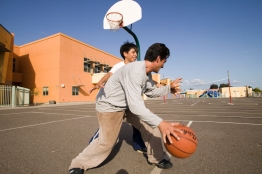For a time, a few years back, my friends and I used to play pick-up soccer every Sunday at a high school in my neighborhood. As many as 30 people, mostly adults in their twenties and thirties, would show up for a match on a particularly nice day. New moms would bring their babies to cheer on their husbands. It was good, clean fun. But then one Sunday in August we showed up at the soccer field and found the gate locked. Apparently, there had been an instance of vandalism -- and that was it, we were locked out. And that was the end of our soccer matches.

Locked-up schoolyards are pretty common across the United States. They might be active places, but only from 8 a.m. to 3 p.m., and only nine months a year. Many times, concerns about liability or crime close off schoolyards off to the greater community.
A new initiative from the Safe Routes to School National Partnership aims to correct that. As part of the larger fight to curb obesity, SRTS is taking on what are known as "shared use agreements." These agreements help maximize the benefits of public land by formally opening schoolyards, tracks, and even gymnasiums that were once off-limits to the general public -- and even to school kids after school hours were over.
"We want the kids to have a place to play beyond the school day," said Mikaela Randolph, who is leading the initiative, "but we also want the parent to have a place to be active as well. We really see that as an opportunity for modeling an active lifestyle. It increases the feeling of community, you get to know your neighbors, it’s kind of a convening space for multiple generations."
The SRTS National Partnership will be working with states across the U.S. to help establish the legal groundwork for shared use agreements. They are being supported by the Robert Wood Johnson Foundation's anti-obesity initiative.
Some schools already have informal shared-use agreements, places where there's a culture of community ownership -- like our soccer grounds, pre-vandalism. But others need special encouragement and assistance.
As the benefits of shared use have gained wider recognition, there has been an increase in the number of communities seeking formal agreements. Randolph said no one is really sure how many shared use agreements currently exist across the United States. But part of her work may include mapping these innovators and developing a catalog of best practices.

One local model, said Randolph, is the Charlotte-Mecklenburg Joint-Use Task Force, which is exploring how municipal agencies can maximize public investments in land with shared use agreements. The county even makes school siting decisions with an eye toward shared use. Other communities partner with outside organizations, like the YMCA, to provide afterschool programming on the grounds. The goal is to establish an agreement that is mutually beneficial and won't leave the school at risk for liability.
Meanwhile, many states -- with leadership from statewide SRTS coordinators -- are already making progress. Mississippi recently passed a law relieving schools and school districts of liability if someone suing one of its facilities is injured, according to the Safe Routes to School National Partnership. Tennessee took similar action last year. There are also hopeful efforts underway in Ohio and Florida.
"We really want to address and clarify liability – that seems to be one of the biggest concerns," said Randolph. "They don’t want to be held liable if someone was injured on their campus outside of school hours."
One of the newest adherents to the shared use concept is the Los Angeles Unified School District. The district recently established four pilot shared spaces as part of its "Healthy Spaces, Healthy People" initiative. Prior to that, in many L.A. neighborhoods, amenities like playgrounds and baseball fields were closed off to the public with eight-foot-high locked gates, said Randolph, who helped forge the pilot agreements in seven county school districts in her former role at the L.A. County Department of Public Health. An evaluation of the program found that it led to greater levels of physical activity for neighborhood residents.
"It’s really seen as an obesity strategy to increase physical activity," said Randolph. "We really frame this as a health issue and an equity issue."
"For many of us who maybe grew up in different communities, this idea of having the school grounds locked to the community is a little bit foreign," said Randolph. "Public dollars going to that. It really does become an issue of, 'Yes. we do have a right to these spaces.'"





